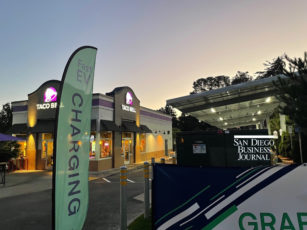Some Taco Bell Customers Will Soon Be Able To Order A Chalupa And EV Charge
Ed Garsten Senior Contributor, Forbes
A project underway at a Taco Bell in South San Francisco likely to expand will give electric vehicle owners the chance to grab some fast food and a fast charge. Six RTM direct current (DC) fast chargers built by Tritium and managed by software created by ChargeNet will be installed in the restaurant’s parking lot taking up six slots, along with a solar array occupying another 10.
The two companies are working in conjunction with Diversified Restaurant Group, which operates nearly 250 Taco Bell and Arby’s restaurants in five states with funding from the California Energy s Commission’s California Electric Vehicle Infrastructure Project (CALeVIP) and the California Public Utilities Commission’s (CPUC) Self-Generation Incentive Program (SGIP).
“It’s a tremendous benefit for everybody. In the end its the driver that benefits. They can pull up to an easily accessible place they know well, they can fill up a charge, they can eat a sandwich or great meal…at one of the Yum brand’s Taco Bells then drive away with 50-plus miles added to their battery,” said Tritium President of the Americas Mike Calise in an interview.
The 75 kilowatt Tritium RTM fast chargers can provide up to 46 miles of range in 10 minutes and will accept payment through ChargeNet’s mobile app and a credit card reader on the charger. ChargeNet is looking to integrate food ordering and payment into the process.
Combining solar and battery power is a key element of the project, according to Calise, because the solar array provides both a backup and a savings.
“We’re getting renewable energy from sun at very cheap rates. It actually is connected to the grid which is important because legally it needs to be connected, but also there’s a utility involved,” explained Calise. “Also, there’s battery storage, which allows that solar to collect stored in battery so that in the case of a power outage these still charge up your vehicle but more importantly than that they also actually become what’s called an energy asset to the utility.”
The project broke ground at the beginning of October and is expected to be completed by the end of the month. Diversified Restaurant Group paid no upfront costs and will benefit from a portion of the proceeds from the chargers as well as any increase in business the chargers may attract.
“We’re always looking for opportunities to do things that haven’t been done before and especially those that create a ‘win-win’ for our customers, the community and our business,” said S.G. Ellison, President of Diversified Restaurant Group, in a statement.
ChargeNet Stations
“Our goal is to replace the refueling experience that Americans know with a charging experience that is fast, convenient, and inviting,” added Tosh Dutt, CEO of ChargeNet. “Our first installation is just the beginning of realizing that goal, and will be the first of many as we look to expand charging opportunities throughout the Bay Area and other parts of the country in the hopes of increasing adoption of EVs, especially in lower-income areas.”
Indeed, funding from the various California agencies is helping to power that goal by not only encouraging EV adoption but by supporting communities in high fire-threat areas, communities that have experienced two or more utility Public Safety Power Shut-offs and low-income and medically vulnerable customers.
Tritium’s Mike Calise expects the idea of combining fast food and fast charging will quickly take off and whet consumers’ appetites for both EVs and tasty calories, predicting, “If you can put these DC fast chargers in local proximity neighborhoods, like this is, then people feel OK, it’s safe to dip my toe in the water, not only that, I’m gonna buy an EV and I’m gonna get a charge really quickly and oh, by the way, I’m gonna get some really good Taco Bell food.”


